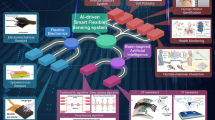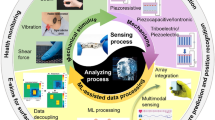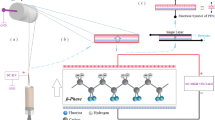Abstract
The aim of this work is to model and analyze the behavior of a new smart nano force sensor. To do so, the carbon nanotube has been used as a suspended gate of a metal-oxide-semiconductor field-effect transistor (MOSFET). The variation of the applied force on the carbon nanotube (CNT) generates a variation of the capacity of the transistor oxide-gate and therefore the variation of the threshold voltage, which allows the MOSFET to become a capacitive nano force sensor. The sensitivity of the nano force sensor can reach 0.124 31 V/nN. This sensitivity is greater than results in the literature. We have found through this study that the response of the sensor depends strongly on the geometric and physical parameters of the CNT. From the results obtained in this study, it can be seen that the increase in the applied force increases the value of the MOSFET threshold voltage VTh. In this paper, we first used artificial neural networks to faithfully reproduce the response of the nano force sensor model. This neural model is called direct model. Then, secondly, we designed an inverse model called an intelligent sensor which allows linearization of the response of our developed force sensor.
Similar content being viewed by others
References
P. Rougeot, S. Régnier, N. Chaillet. Forces analysis for micro–manipulation. In Proceedings of IEEE International Symposium on Computational Intelligence in Robotics and Automation, Espoo, Finland, pp. 105–110, 2005. DOI: 10.1109/CIRA.2005.1554262.
N. Kato, I. Suzuki, H. Kikuta, K. Iwata. Force–balancing microforce sensor with an optical–fiber interferometer. Review of Scientific Instruments, vol. 68, no. 6, pp. 2475–2478, 1997. DOI: 10.1063/1.1148171.
M. Kalantari, J. Dargahi, J. Kövecses, M. G. Mardasi, S. Nouri. A new approach for modeling piezoresistive force sensors based on semiconductive polymer composites. IEEE/ASME Transactions on Mechatronics, vol. 17, no. 3, pp. 572–581, 2012. DOI: 10.1109/TMECH.2011.2108664.
A. S. Krajewski, K. Magniez, R. J. N. Helmer, V. Schrank. Piezoelectric force response of novel 2D textile based PVDF sensors. IEEE Sensors Journal, vol. 13, no. 12, pp. 4743–4748, 2013. DOI: 10.1109/JSEN.2013.2274151.
K. F. Lei, K. F. Lee, M. Y. Lee. A flexible PDMS capacitive tactile sensor with adjustable measurement range for plantar pressure measurement. Microsystem Technologies, vol. 20, no. 7, pp. 1351–1358, 2014. DOI: 10.1007/s00542–013–1918–5.
E. Peiner, L. Doering. Force calibration of stylus instruments using silicon microcantilevers. Sensors and Actuators A, vol. 123–124, pp. 137–145, 2005. DOI: 10.1016/j.sna. 2005.02.031.
R. Pérez, N. Chaillet, K. Domanski, P. Janus, P. Grabiec. Fabrication, modeling and integration of a silicon technology force sensor in a piezoelectric micro–manipulator. Sensors and Actuators A, vol. 128, no. 2, pp. 367–375, 2006. DOI: 10.1016/j.sna.2006.01.042.
T. L. Li, L. Q. Li, G. Y. Zhang. A nano–scaled force sensor based on a photonic crystal nanocavity resonator and a microcantilever. ECS Journal of Solid State Science and Technology, vol. 3, no. 7, pp. Q146–Q151, 2014. DOI: 10. 1149/2.0151407jss.
L. Q. Li, T. L. Li, F. T. Ji, W. P. Song, G. Y. Zhang, Y. Li. The effects of optical and material properties on designing of a photonic crystal mechanical sensor. Microsystem Technologies, vol. 23, no. 8, pp. 3271–3280, 2017. DOI: 10.1007/s00542–016–3186–7.
S. Iijima. Helical microtubules of graphitic carbon. Nature, vol. 354, no. 6348, pp. 56–58, 1991. DOI: 10.1038/354056a0.
A. Eatemadi, H. Daraee, H. Karimkhanloo, M. Kouhi, N. Zarghami, A. Akbarzadeh, M. Abasi, Y. Hanifehpour, S. W. Joo. Carbon nanotubes: Properties, synthesis, purification, and medical applications. Nanoscale Research Letters, vol. 9, no. 1, pp. 393, 2014. DOI: 10.1186/1556–276X–9–393.
O. Kanoun, C. Müller, A. Benchirouf, A. Sanli, T. N. Dinh, A. Al–Hamry, L. Bu, C. Gerlach, A. Bouhamed. Flexible carbon nanotube films for high performance strain sensors. Sensor, vol. 14, no. 6, pp. 10042–10071, 2014. DOI: 10.3390/s140610042.
Y. G. Li, R. Ahuja, J. A. Larsson. Communication: Origin of the difference between carbon nanotube armchair and zigzag ends. The Journal of Chemical Physics, vol. 140, no. 9, Article number 091102, 2014. DOI: 10.1063/1.4867744.
L. Marty, A. Iaia, M. Faucher, V. Bouchiat, C. Naud, M. Chaumont, T. Fournier, A. M. Bonnot. Self–assembled single wall carbon nanotube field effect transistors and AFM tips prepared by hot filament assisted CVD. Thin Solid Films, vol. 501, no. 1–2, pp. 299–302, 2006. DOI: 10.1016/j.tsf.2005.07.218.
C. H. Ke, H. D. Espinosa. Feedback controlled nanocantilever device. Applied Physics Letter, vol. 85, no. 4, pp. 681–683, 2004. DOI: 10.1063/1.1767606.
D. Mtsuko, A. Koshio, M. Yudasaka, S. Iijima, M. Ahlskog. Measurements of the transport gap in semiconducting multiwalled carbon nanotubes with varying diameter and length. Physical Review B, vol. 91, no. 19, Article number 195426, 2015. DOI: 10.1103/PhysRevB.91.195426.
X. L. Tang, A. El Hami, K. El–Hami. Mechanical properties investigation of single–walled carbon nanotube using finite element method. Key Engineering Materials, vol. 550, pp. 179–187, 2013. DOI: 10.4028/www.scientific. net/KEM.550.179.
C. Mungra, J. F. Webb. Free vibration analysis of single–walled carbon nanotubes based on the continuum finite element method. Global Journal of Technology & Optimization, vol. 6, no. 2, Article number 1000173, 2015. Doi: 10.4172/2229–8711.1000173.
C. Y. Li, T. W. Chou. A structural mechanics approach for the analysis of carbon nanotubes. International Journal of Solids and Structures, vol. 40, no. 10, pp. 2487–2499, 2003. DOI: 10.1016/S0020–7683(03)00056–8.
D. H. Wu, W. T. Chien, C. S. Chen, H. H. Chen. Resonant frequency analysis of fixed–free single–walled carbon nanotube–based mass sensor. Sensors and Actuators A, vol. 126, no. 1, pp. 117–121, 2006. Doi: 10.1016/j.sna.2005. 10.005.
S. Prabhu, S. Bhaumik, B. K. Vinayagam. Finite element modeling and analysis of zigzag and armchair type single wall carbon nanotube. Journal of Mechanical Engineering Research, vol. 4, no. 8, pp. 260–266, 2012. DOI: 10.5897/JMER12.025.
I. H. Song, P. K. Ajmera. A laterally movable gate field effect transistor. Journal of Microelectromechanical Systems, vol. 18, no. 1, pp. 208–216, 2009. Doi: 10.1109/JMEMS.2008.2008623.
F. Djeffal, Z. Dibi, M. L. Hafiane, D. Arar. Design and simulation of a nanoelectronic DG MOSFET current source using artificial neural networks. Materials Sciences and Engineering: C, vol. 27, no. 5–8, pp. 1111–1116, 2007. Doi: 10.1016/j.msec.2006.09.005.
F. Djeffal, S. Guessasma, A. Benhaya, M. Chahdi. An analytical approach based on neural computation to estimate the lifetime of deep submicron MOSFETs. Semiconductor Science and Technology, vol. 20, no. 2, pp. 158–164, 2005. DOI: 10.1088/0268–1242/20/2/010.
F. Menacer, A. Kadri, F. Djeffal, Z. Dibi, H. Ferhati. Modeling of boron nitride–based nanotube biological sensor using neural networks. Proceedings of the 17th International Conference on Sciences and Techniques of Automatic Control and Computer Engineering, Sousse, Tunisia, 2016. DOI: 10.1109/STA.2016.7951987.
F. Menacer, A. Kadri, F. Djeffal, Z. Dibi. Modeling and investigation of smart capacitive pressure sensor using artificial neural networks. Proceedings of the 6th International Conference on Systems and Control, Batna, Algeria, 2017. DOI: 10.1109/ICoSC.2017.7958746.
Acknowledgement
The authors would like to thank the Mechanical Engineering Laboratory of the University of Biskra, Algeria, for their important help and support in developing the numerical models using ANSYS simulator.
Author information
Authors and Affiliations
Corresponding author
Additional information
Recommended by Associate Editor Xun Chen
Farid Menacer received the B. Eng. degree in electronics control, and the M. Eng. degree in instrumentation from Batna University, Algeria in 1996 and 2011, respectively.
His research interests include neuronal networks, sensors and intelligent system.
Abdelmalek Kadr received the B. Eng. degree in electronics control, and the M. Eng. degrees in instrumentation from Batna University, Algeria in 1995 and 2012, respectively.
His research interests include neuronal networks, sensors, intelligent system and nanotechnology
Zohir Dibi received the B. Sc. degree in electronics engineering from University of Setif, Algeria in 1994, the M. Eng. and Ph. D. degrees from University of Constantine, Algeria in 1998 and 2002, respectively. He has been the head of Electronics Department. He is currently an assistant professor in Department of Electrical and Electronic Engineering and vice-dean of the Faculty of Engineering, Batna University, Algeria.
His research interests include neural networks, sensors, smart sensors, and organic devices.
Rights and permissions
About this article
Cite this article
Menacer, F., Kadr, A. & Dibi, Z. Modeling of a Smart Nano Force Sensor Using Finite Elements and Neural Networks. Int. J. Autom. Comput. 17, 279–291 (2020). https://doi.org/10.1007/s11633-018-1155-6
Received:
Accepted:
Published:
Issue Date:
DOI: https://doi.org/10.1007/s11633-018-1155-6




